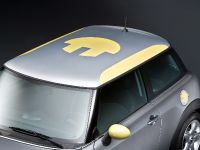MINI's "Perpetual Motion" Magnetic Propulsion System
MINI USA looks set to take a world lead in fuel efficiency with the announcement of a revolutionary magnetic propulsion system that will extend the range of its MINI E to several hundred, possibly even thousands of miles, on a single overnight charge of electricity.
Drawing on the same Magnetic Tow Technology (MTT) which was announced by BMW in the UK today, MINI USA has developed its own unique Propulsion / Repulsion 0401 (PR0401) System that is just one short step away from perpetual motion in an automobile.
MINI's PR 0401 System uses a series of magnets situated in the MINI E's moving and fixed parts of each of its four wheel hubs to both pull and push the wheels in the desired direction, exploiting the magnets' natural tendency to attract and repel. Not only does this system allow the MINI PR to travel extraordinary distances for just a few cents, it produces virtually no noise as the electric motor can be switched off once the car is moving.
Professor Lirpa Loof, Head of Magnetic Attraction Technology at MINI USA, said: "The Mini E is already leading the way in EV performance, reliability and eco-friendliness but this amazing new system will push it onto another level. We could soon be seeing families travel across the USA from coast to coast for just a couple of bucks."
"The only energy this system uses is a small draw on the battery to start the vehicle moving forward and then the magnets take over and their natural properties do the rest. This has to be the ultimate range extender," he added. "Anyone who has played with magnets as a kid or travelled on a Maglev train will understand precisely how this technology works and the kind of performance we are talking about."
Once moving, only tiny amounts of electric current are required to switch on and off the magnets, as the polarity of the fixed and moving magnets is rapidly switched from positive to negative. The magnets first attract and then quickly repel each other pushing the wheels in the desired direction – either forward or reverse.
One challenge that Professor Loof faced with the PR system was the speed of the MINI EV PR... and how to control it! The speed at which the magnets attract and repel each other is instantaneous, which means in theory the vehicle is capable of phenomenal speeds, restricted only by the time it takes to switch the magnets' polarity and the wind resistance and drag of the MINI PR's body. The MINI EV PR development vehicles are currently restricted to a top speed of 250 mph.
"For years, engineers have dreamed of developing perpetual motion for transport," said Professor Loof, "And thanks to MINI PR, it looks like we are almost there."
















